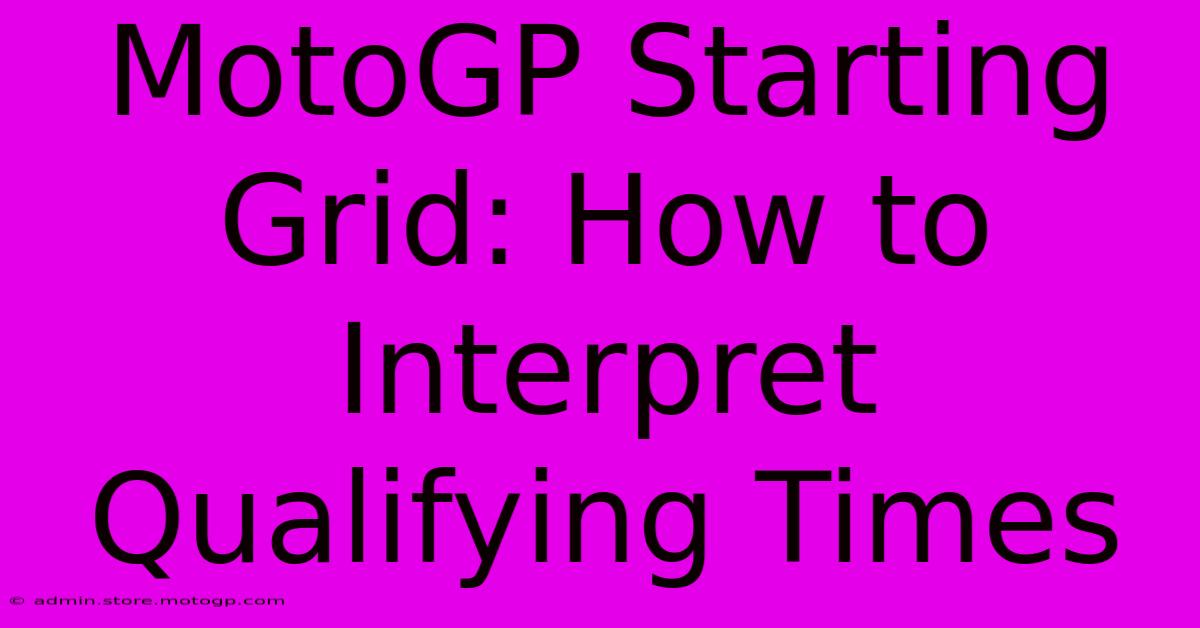MotoGP Starting Grid: How To Interpret Qualifying Times

Table of Contents
MotoGP Starting Grid: How to Interpret Qualifying Times
MotoGP, the pinnacle of motorcycle racing, boasts incredibly close competition. Understanding the starting grid, derived from qualifying times, is crucial for predicting race outcomes and appreciating the nuances of the sport. This guide breaks down how to interpret those crucial qualifying times and what they reveal about rider performance and race strategy.
Decoding the Qualifying Sessions
MotoGP qualifying is a multi-stage process designed to separate the fastest riders from the rest. The process typically involves:
- Free Practice (FP): These sessions allow riders to test different setups, tires, and strategies, gathering crucial data for qualifying. FP times don't directly influence grid position but are highly indicative of potential.
- Qualifying 1 (Q1): The slowest riders from the combined FP times compete in Q1. Only the top two riders from Q1 progress to Q2.
- Qualifying 2 (Q2): The top ten riders from the combined FP times, plus the two qualifiers from Q1, fight for pole position and the coveted front-row spots.
The ultimate goal? Achieving the fastest lap time in Q2, securing pole position. This prime starting spot offers a significant advantage at the start of the race.
Understanding the Times and Their Significance
Qualifying times are presented in minutes, seconds, and milliseconds (e.g., 1:58.723). Even tiny differences can separate the top riders.
-
The Significance of Small Margins: A difference of tenths or even hundredths of a second often separates the top riders. These minor discrepancies highlight the intense competition and the precision required at this level of motorsport. A rider might gain a crucial advantage through superior cornering, superior braking, or a perfect slipstream.
-
Tire Choice and Track Conditions: Analyzing qualifying times also involves considering tire selection (soft, medium, hard) and track conditions (temperature, grip). A rider's choice of tire and their ability to adapt to changing conditions significantly influence their lap time.
-
Race Pace vs. Qualifying Pace: While a fast qualifying lap is vital, it doesn't always translate to race pace. Some riders prioritize qualifying performance, sacrificing potential race setup. Others might prioritize race setup, accepting a slightly less optimal qualifying time to ensure a stronger race performance. Analyzing a rider's performance across both free practice and qualifying can help discern this strategic approach.
Factors Affecting Qualifying Times
Numerous factors can impact a rider's qualifying performance:
- Rider Skill and Experience: The rider's skill in accelerating, braking, cornering, and maintaining consistent pace is paramount. Experience plays a vital role, allowing riders to learn the track, fine-tune their bike setup, and adapt to changing conditions.
- Motorcycle Setup: The bike's setup – suspension, aerodynamics, engine mapping – significantly affects lap times. Even small adjustments can yield significant improvements.
- Track Conditions: Grip levels, temperature, and weather greatly influence lap times. A rider's ability to adapt to changing track conditions is crucial.
- Tire Selection: Choosing the right tires for the conditions is essential. Soft tires provide more grip but degrade faster; hard tires offer better longevity but less grip.
Interpreting the Starting Grid
The starting grid, arranged according to qualifying times, visually represents the pecking order heading into the race.
- Front Row (Positions 1-3): These riders have the best chance of leading the race early on.
- Second Row (Positions 4-6): These riders are well-positioned to challenge for the lead, particularly at the start.
- Third and Fourth Rows: Riders in these positions face a more difficult task, often needing to battle through traffic to reach the front.
Analyzing the starting grid in conjunction with the qualifying times and riders' race performance history allows viewers to develop a deeper understanding of the potential race dynamics.
Conclusion
Interpreting MotoGP qualifying times involves understanding the qualifying format, recognizing the subtle differences in lap times, and considering the numerous factors impacting performance. By analyzing these elements, viewers gain a much richer appreciation for the intricacies of MotoGP and the strategic choices made by teams and riders. The starting grid is not just a snapshot of qualifying success; it's a window into the potential race battles to come.

Thank you for visiting our website wich cover about MotoGP Starting Grid: How To Interpret Qualifying Times. We hope the information provided has been useful to you. Feel free to contact us if you have any questions or need further assistance. See you next time and dont miss to bookmark.
Featured Posts
-
Beyond Protection The Style Of A Moto Gp Helmet
Feb 19, 2025
-
Experience The Legend Iconic Motorcycle Helmet Replicas
Feb 19, 2025
-
Cota Qualifying Your Cota Qualifying Advantage
Feb 19, 2025
-
Club Si Austin F1 Your All Access Pass To The Action
Feb 19, 2025
-
High Speed Drama Moto Gp Accident Caught On Camera
Feb 19, 2025
